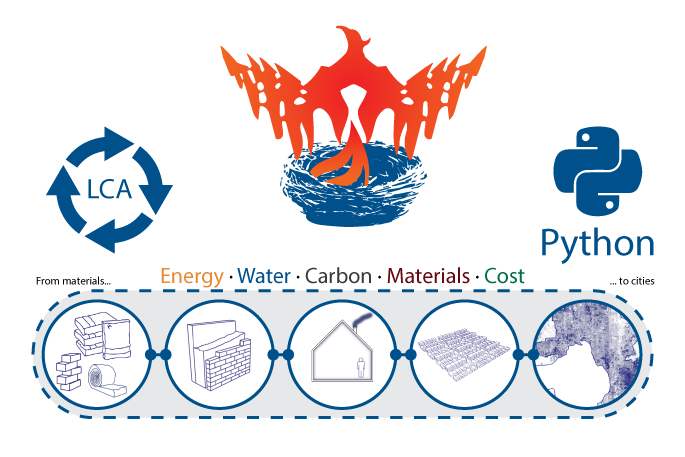Nested Phoenix: a multi-scale model for life cycle environmental performance in the built environment
This projects aims to develop one of the most advanced computer models to measure and improve life cycle environmental performance in the built-environment, across its scales, from construction materials, to cities.

Rationale
With climate change, resource depletion and global warming accelerating at an unprecedented pace and reaching record levels year on year, action is urgently needed to try and mitigate the environmental effects of human activities. Cities and their built stocks are responsible for a significant share of these effects and there environmental performance needs to be substantially improved. In order to do so, decision-makers, namely architects, engineers, urban designers, town planners and others, need to have the necessary understanding of these systems as well as reliable information. Modelling cities and their built stocks enables decision makers to quantify their environmental performance, compare alternatives and identify solutions. However, existing models to evaluate life cycle environmental performance in the built environment are flawed in a number of ways: they typically do not cover the entire system boundary when it comes to embodied flows; and they often focus on a single scale, omitting linkages between scales. This can lead to suboptimal solutions that can paradoxically result in a lower overall environmental performance, further exacerbating climate change, resource depletion and global warming.
Aim
This project aims to develop a comprehensive model for quantifying the environmental performance of cities and their built stocks, across spatial scales, time and multiple environmental flows. This unprecedented procedural, temporal and spatial coverage is a critical improvement over existing models. The model will provide the urgently needed capacity to comprehensively, yet reliably measure and improve environmental performance of the built environment. This will empower architects, engineers, consultants, planners, and urban designers, to identify solutions that reduce overall life cycle environmental impacts, helping avoid devastating disruptions to ecosystems and human society.
Impact
This research will provide the most advanced and comprehensive life cycle environmental model for the built environment to date. Through the investigation of various case studies in four different countries, the research will generate new knowledge regarding the overall environmental performance of cities and their built stocks. It will ensure that reduction in the environmental effects of built stocks are not simply shifted to another spatial scale, life cycle stage or moment in time. This will provide the urgently needed information for decision-making that leads to net overall environmental performance of the built environment.
Project details
Major Sponsors
United Nations Human Settlements Program — UN-Habitat
Faculty of Architecture, Building and Planning
Research Partners
United Nations Human Settlements Program — UN-Habitat
Project Team and Contacts
Dr André Stephan
A/Prof Robert H. Crawford
Dr Victor Bunster
Dr Georgia Warren-Myers
Dr Sareh Moosavi
Contact
Dr André Stephan